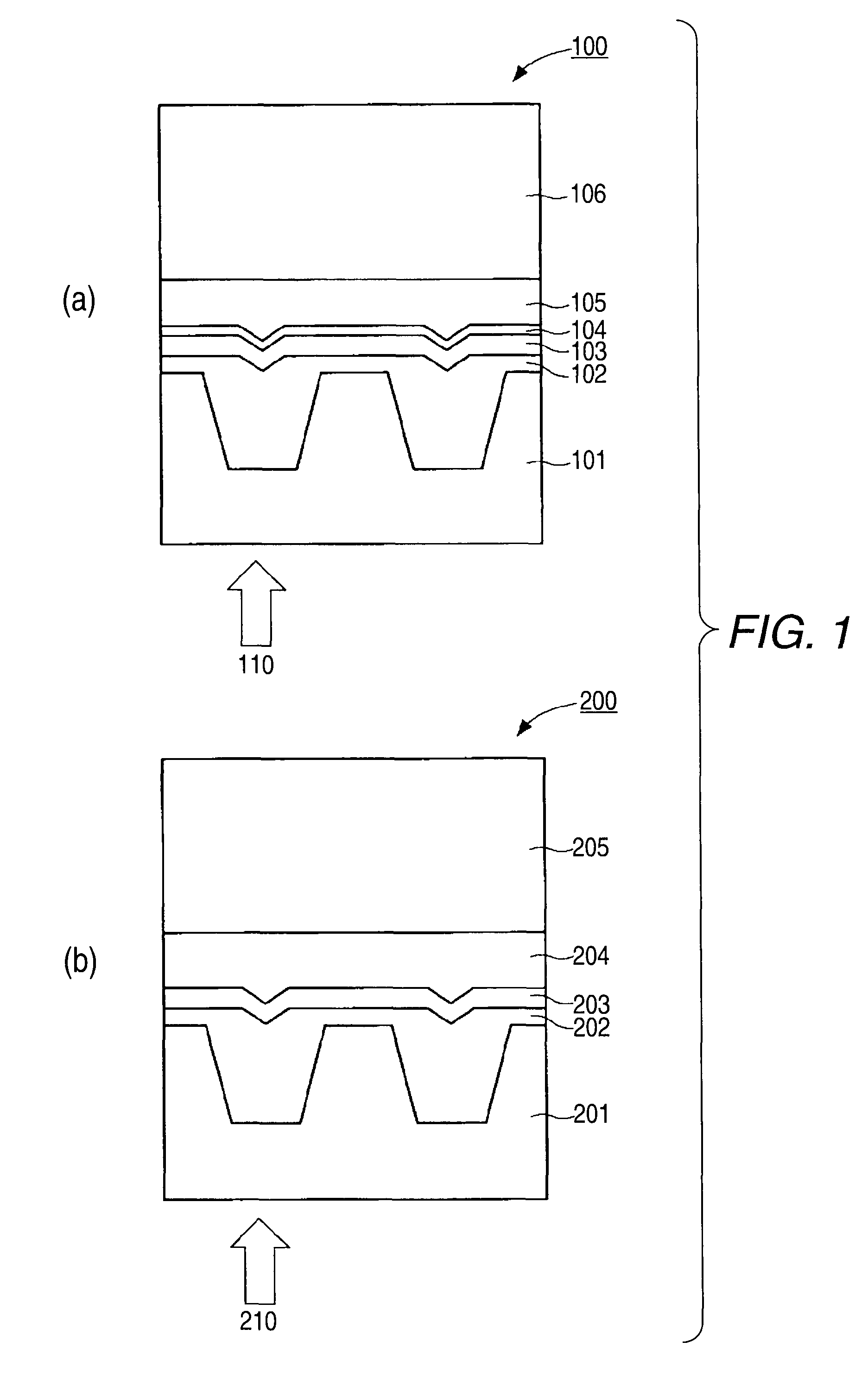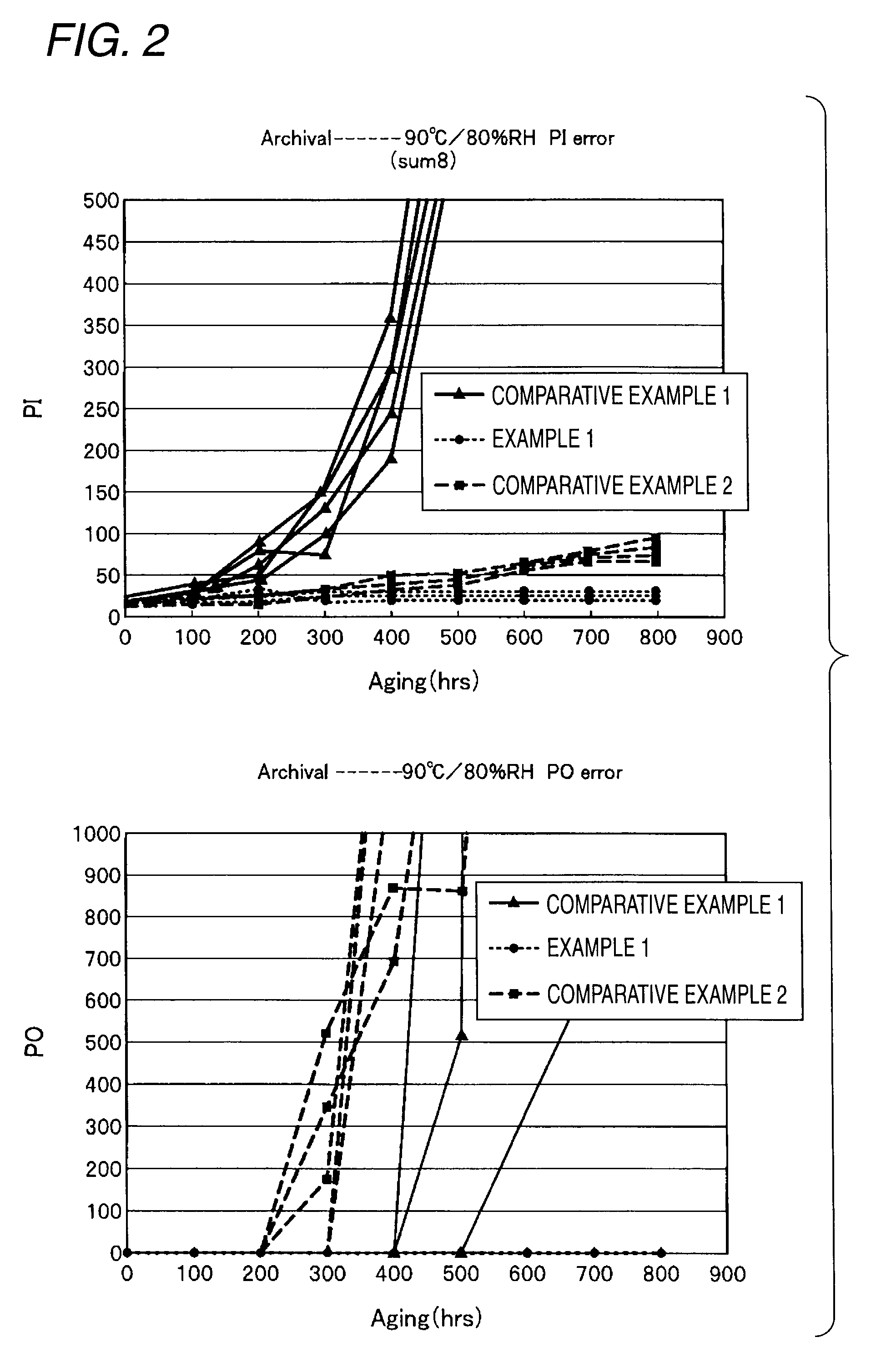Optical recording medium
a recording medium and optical technology, applied in the field of optical recording mediums, can solve the problems of inability to obtain sufficient recording characteristics, inability to meet the requirements of recording/reading light, and inability to achieve satisfactory recording characteristics, etc., to achieve satisfactory storage stability, reduce the stress caused by recording/reading light, and high quality
- Summary
- Abstract
- Description
- Claims
- Application Information
AI Technical Summary
Benefits of technology
Problems solved by technology
Method used
Image
Examples
example 1
Preparation of Optical Recording Medium
[0128]First, a polycarbonate was injection-molded with a nickel stamper having a groove formed in the surface thereof to thereby form a resin substrate which had a diameter of 120 mm and a film thickness of 0.60 mm and had a groove having a pitch of 0.74 μm, width of 320±50 nm, and depth of 150±25 nm. A tetrafluoropropanol solution (concentration, 1.5% by weight) of a mixture of dye A and dye B (dye A / dye B=60% by weight / 40% by weight) which were metal-containing azo dyes respectively represented by the following chemical formulae, as an organic dye compound, was prepared. This was dropped onto the resin substrate and subjected to spin coating.
[0129]Thereafter, the coating film was dried at 70° C. for 30 minutes to form a recording layer. In the groove part of the resin substrate, the recording layer had a film thickness of about 80 nm and a value of OD (optical density) as measured at a wavelength of about 595 nm with ETA-RT, manufactured by E...
examples 2 to 5
[0152]Laminated disks were produced in completely the same manner as in Example 1, except that the film thicknesses of the first reflective layer which was made of pure silver, and the second reflective layer which was made of pure gold, were changed as shown in Table 3.
[0153]The disks of Examples 2 to 5 and the disks of Example 1 and Comparative Examples 1 to 6 were subjected to the same recording as in Example 1 and then examined for reflectance and jitter. The values of reflectance (average for disk samples) and jitter value (average for disk samples) for these disks are shown in Table 3. These measured values were obtained by examining the disks before the durability test.
[0154]
TABLE 3Reflectance, Jitter Value (average for disks)Example 1Example 2Example 3Example 4Example 5First reflectivepurepurepurepurepurelayersilversilversilversilversilver100 nm120 nm140 nm140 nm140 nmSecond reflectivepure goldpure goldpure goldpure goldpure goldlayer 50 nm 50 nm 50 nm 30 nm 20 nmTotal refle...
example 6
Preparation of Optical Recording Medium
[0159]First, a polycarbonate was injection-molded with a nickel stamper for CD-R production which had a groove formed in the surface thereof to thereby form a resin substrate which had a diameter of 120 mm and a thickness of 1.2 mm and had a groove having a pitch of 1.5 μm. A solution prepared by dissolving a phthalocyanine-based dye as an organic dye compound in an organic solvent was dropped onto the resin substrate and subjected to spin coating. Thereafter, the coating film was dried with heating to form a recording layer. The film thickness of the recording layer was regulated so that the recording layer had an OD value of 0.57 as measured at the maximum absorption wavelength for the dye compound.
[0160]As soon as possible after the formation of the recording layer, a sputtering film of pure silver was deposited in a film thickness of 80 nm as a first reflective layer on the recording layer. Furthermore, a sputtering film of pure gold was de...
PUM
| Property | Measurement | Unit |
|---|---|---|
| length | aaaaa | aaaaa |
| mark length | aaaaa | aaaaa |
| wavelength | aaaaa | aaaaa |
Abstract
Description
Claims
Application Information
 Login to View More
Login to View More - R&D
- Intellectual Property
- Life Sciences
- Materials
- Tech Scout
- Unparalleled Data Quality
- Higher Quality Content
- 60% Fewer Hallucinations
Browse by: Latest US Patents, China's latest patents, Technical Efficacy Thesaurus, Application Domain, Technology Topic, Popular Technical Reports.
© 2025 PatSnap. All rights reserved.Legal|Privacy policy|Modern Slavery Act Transparency Statement|Sitemap|About US| Contact US: help@patsnap.com



